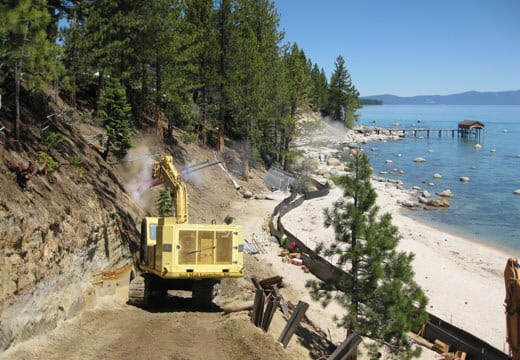
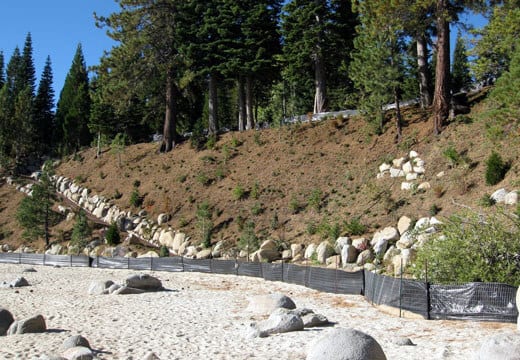
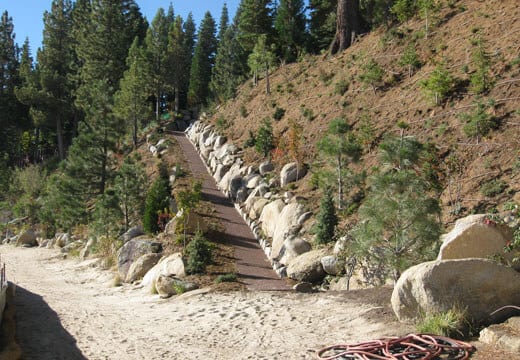
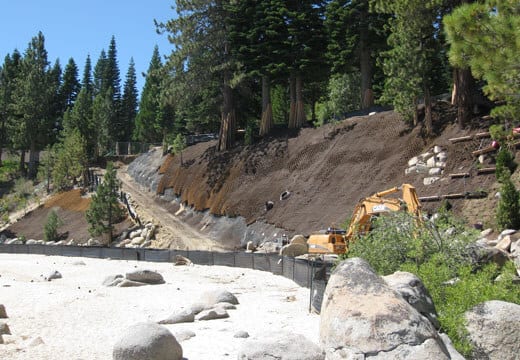
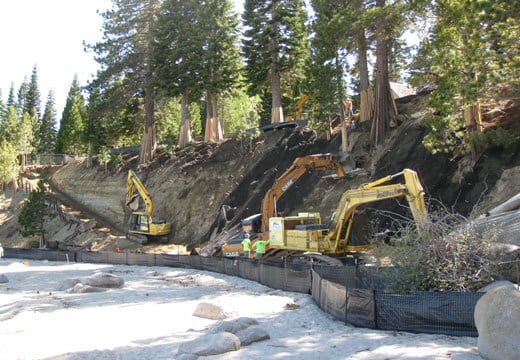
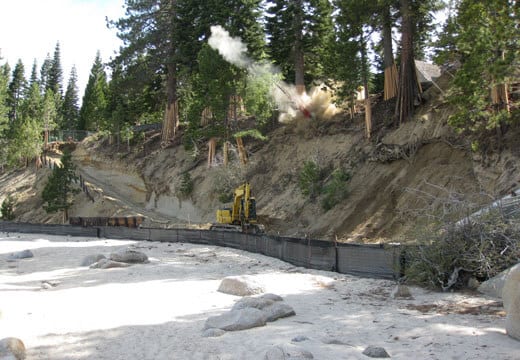






Bluff erosion and soil retention are an ever-present problem along the shoreline of pristine Lake Tahoe. One such area presented itself during the planning phase of an estate reconstruction project along the west shore of Lake Tahoe. In this situation, the bluff stabilization situation was intensified by the desire to build a high-end housing structure just feet from the top edge of the bluff while planning to restore the bluff face and construct a walking path to the beach below. In addition, because of strict environmental regulations, most of the work would need to take place from the top of the bluff, thus requiring specialized equipment and innovative soil retention techniques.
These factors were made even more difficult by stringent Tahoe Regional Planning Agency (TRPA) and local county permitting requirements that limited construction from May 1st to October 15th and required a massive amount of BMPs before any rains and/or before October 15th. The project’s ultimate goal was to protect, strengthen, support, preserve and provide global stability to the existing bluff surface without noticeably changing its appearance. After considerable thought and consultation with erosion control vendors and consultants, a hybrid biotechnical solution was chosen – an array of stabilization techniques. Ultimately, the engineered soil repair consisted of a soil nail wall constructed with a combination of launched soil nails, steel mesh, and a specialty custom vegetated. GeoCell coir cellular confinement product.
The Soil Nail Launcher™ was the tool chosen to install the anchors because of its minimal installation impact and faster production rates compared to drilled soil nails, lower cost, and the ability to perform the installation from the top of the bluff (no need for equipment on the beach). The soil nailing reinforced the locally unstable soil mass by transferring the nail’s tensile and shear resistance through the sliding soil’s failure plane. The galvanized steel mesh placed on the slope was carefully tensioned across the entire slope face. The mesh’s function was to provide a medium to attach the coir cellular confinement for soil retention and to act as the last defense for erosion in the event of localized coir failure. At the bottom of the slope, native rocks were hand selected and placed to provide slope buttressing and to protect against high water wave action. The rocks were installed after the mesh’s placement; thus, the rocks provided another source of tension as they were set in place.
The success of the entire stabilization system depended mainly on the erosion control and beatification provided by the vegetated surface treatment. The coir cellular confinement surface treatment was installed immediately after the placement of the steel mesh and native rock. Vegetation selected for planting within the cells included large, deeply rooted woody shrubs, forbs, sub-shrubs, ground cover, and grasses chosen based on esthetic appeal and their ability to retain soil.
The construction process was completed before September 15th, 2010. By October, seeds had begun germinating, and plant materials had already exhibited growth. The entire planted area is irrigated by an in-line drip irrigation system providing low volume, low impact supplemental irrigation. From conception to completion, this project took more than three years. Construction took two- and one-half months with more than two years in planning and permitting negotiations.
Contact GeoStabilization International® at 855-579-0536 to learn how our teams are mitigating landslides and providing residential slope stabilization, slope monitoring, soil retention, and landslide prevention services.
If you are interested in a no-obligation site visit to determine if our services fit your geohazard mitigation needs, call us at 855-579-0536 or fill out our contact form.